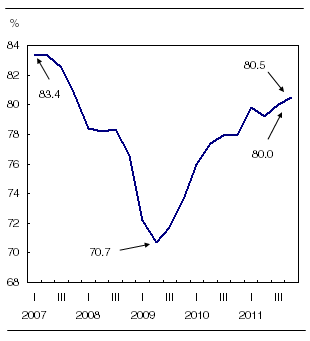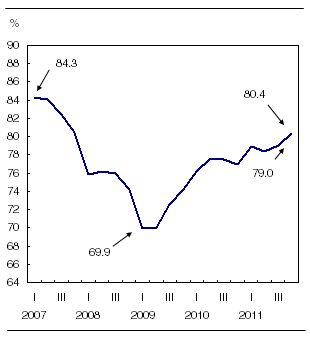Industrial capacity utilization rates
Archived Content
Information identified as archived is provided for reference, research or recordkeeping purposes. It is not subject to the Government of Canada Web Standards and has not been altered or updated since it was archived. Please "contact us" to request a format other than those available.
Related subjects
-
[an error occurred while processing this directive]
Canadian industries operated at 80.5% of their production capacity in the fourth quarter, up slightly from the 80.0% posted in the third quarter. The increase would have been greater if not for the slight decline in the non-manufacturing sector.
With the exception of the second quarter of 2011, which saw a decrease in the capacity utilization rate, the rate has increased steadily since the second quarter of 2009. However, the rate of 80.5% was below that of 83.4% posted in the first quarter of 2007.
The gain of 1.4 percentage points in the fourth quarter for all manufacturing industries was offset by the slight decline posted by the non-manufacturing sector.
Continued upward trend in capacity utilization rate

Chart description: Continued upward trend in capacity utilization rate
Manufacturing: Transportation equipment and machinery industries are contributing the most to the rise in capacity utilization
The manufacturing industry operated at 80.4% of its capacity in the fourth quarter, up 1.4 percentage points from 79.0% in the previous quarter. The upward trend continued, but the rate of 80.4% reached in the fourth quarter was below the 84.3% rate recorded in the first quarter of 2007.
Note to readers
The industrial capacity utilization rate is the ratio of an industry's actual output to its estimated potential output. For most industries, the annual estimates are obtained from the Capital and Repair Expenditures Survey while the quarterly pattern is derived from output-to-capital ratio series, the output being the real gross domestic product at factor cost, seasonally adjusted, by industry.
This program covers all manufacturing and selected non-manufacturing industries.
At the time of this release, rates have been revised back to the first quarter of 2009 to reflect updated source data.
Strength in the manufacturing industry

Chart description: Strength in the manufacturing industry
The capacity utilization rate rose in the fourth quarter in 12 of the 21 major manufacturing industries, declined in 7 and remained relatively stable in 2.
Among the industries reporting increases, the transportation equipment, machinery, chemical products, plastic products and metal products industries contributed the most to this growth. Capacity use declined in some industries, particularly the paper manufacturing industry and, to a lesser extent, the food, printing and related support activities, and petroleum and coal products industries.
Capacity use in the transportation equipment industry rose from 83.6% in the third quarter to 88.5% in the fourth quarter. This rise is mainly the result of motor vehicle and motor vehicle parts manufacturing and also of aerospace product and parts manufacturing.
Higher production of agricultural, construction, and mining and oil and gas field machinery drove up the capacity use rate in the machinery industry by 3.7 percentage points to 82.3%.
The capacity use rate for the chemical products industry was up from 77.2% in the third quarter to 78.8% in the fourth quarter, mostly as a result of the increase in pharmaceutical and medicine manufacturing.
The plastic products industry operated at 74.9% of its capacity, up 3.2 percentage points from the third quarter. The rise was primarily the result of increased production of plastic parts for motor vehicles.
In the metal products manufacturing industry, capacity use rose from 77.3% to 78.8% as a result of increased architectural and structural metals manufacturing.
Lower production in pulp, paper and paperboard mills reduced capacity use in the paper manufacturing industry from 89.9% to 86.4% from the third quarter to the fourth quarter.
Non-manufacturing sector: Slight decline
In the non-manufacturing sector, the oil and gas extraction industry was the only one to experience increased capacity use in the fourth quarter, with its rate rising from 88.2% to 90.3%. The construction industry operated at 77.4% of its capacity, unchanged from the third quarter. Capacity use declined in the electric power generation, transmission and distribution industry and in the mining and quarrying industry.
Increased natural gas extraction is the primary reason for the 2.1 percentage point rise in the capacity utilization rate of the oil and gas extraction industry to 90.3%.
The 2.9 percentage point decline in the capacity utilization rate in the electric power generation, transmission and distribution industry can be traced to reduced demand for electricity.
A significant reduction in potash extraction is the main reason for the decline in capacity use in the mining and quarrying industry from 68.9% to 65.0%.
Available without charge in CANSIM: table 028-0002.
Definitions, data sources and methods: survey number 2821.
Data on industrial capacity utilization rates for the first quarter of 2012 will be released on June 14.
For more information, or to enquire about the concepts, methods or data quality of this release, contact Luc Provençal (613-951-1960; luc.provencal@statcan.gc.ca), Investment, Science and Technology Division.
- Date modified:
